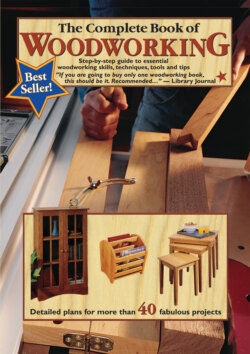Читать книгу Draw Manga - Tom Carpenter - Страница 12
На сайте Литреса книга снята с продажи.
Designing Woodworking Projects
ОглавлениеDecisions, decisions, decisions. That’s what designing a project is all about. Whether you use an existing project plan, modify an existing plan, or develop your own plan, completing a design process is a necessary and rewarding first step before you ever start to build your project.
Most people think of project design as merely deciding the appearance, or the “look” of the finished piece, but there’s much more to it than that. It’s a process that takes you through all the aspects of developing your best ideas, then figuring out the best way to give those ideas form in the shape of a woodworking project. It also helps you plan thoroughly so your project will function as intended. When you’re done with the design process, no decisions should be left unmade.
Essentially, you build your project using drawings, prototypes, and a lot of forethought prior to the construction stage. Think the plan through completely. It is possible to work out some details during the construction, but it’s much better to anticipate and solve those problems in advance, rather than backtracking during the construction and even remaking part of what you’ve already built.
As you work your way through the design process, you’ll want to consider goals such as: creating a piece with an overall appealing look that also fits well in its surroundings; making your style, proportions, wood, moldings and details, hardware, and finish choices all blend together; and making sure your piece will work. If it’s a chair, will it be comfortable? If it’s a storage cabinet, will the items fit well in the space you provide? You’ll also want to consider the tools and construction techniques needed to create your project, and what different ways there may be to achieve similar results better and more efficiently.
Project design may seem like a daunting process, but it doesn’t need to be. In fact, most woodworkers feel that the contrary is true. The more involved and familiar you become with the design process, the more rewarding and easier it and your construction process will become. While you don’t necessarily need to follow the steps of the design process in the order given in the pages that follow, you do need to follow them in some manner. You’ll probably find that you jump from step to step and go back and forth a bit. This is fine as long as you do it all, and do it thoroughly. Get in the habit of using the fundamentals of design, and your finished projects will be much more satisfying and definitely much better accomplished.
Project design is a process that takes you through all the aspects of developing your best ideas then figuring out the best way to give those ideas form in the shape of a woodworking project.
This chapter will guide you through the design process so you can make better design decisions. The process will show you how to analyze your options, and it will explain the reasons why you might choose one option over another. The end results should help ensure that you design a solid project you’ll be happy with. The last part of this chapter will explain different types of drawings you can make to help you visualize your ideas, as well as a section about the process of building prototypes to help you work out your design details quickly and three-dimensionally.
WOODWORKING WORKS A successful woodworking project starts with a well-planned design. You can base your plan on a familiar furnishing, like the Mission-style rocker to the right, or come up with something completely new and completely yours, like the play table and chairs on the left.
What should I build?
Deciding what to build is the point where the design process seems to always begin.
Most often, the desire to build something comes from a specific need: Maybe the need is to replace an old, worn out piece of furniture, or to build a piece of furniture to supplement the furnishings you already have. Perhaps you need an entertainment center to organize and store your audio and video equipment and accessories, or a bookcase to hold all of your books. Maybe your goal is as simple as the desire to build something. Or perhaps you want to challenge your woodworking skills by trying something different or learning something new. Sometimes even the desire to make something in a style you haven’t worked in before is reason enough to get you started.
I recently built myself a new desk. My old desk got too small for all the things I wanted close at hand and the desktop was jammed with computer equipment, leaving me no room to work comfortably. My office was large enough to handle a much bigger desk. So there I was: I had a need to fill and I decided to design and build a new desk for myself. And it turned out great—mostly because I spent a lot of time with the design process.
Deciding what to build is probably the easiest part of the design process. All it takes is a little imagination and some planning. And remember that a healthy desire to explore new techniques is what makes woodworking a hobby, not a chore.
~Bruce Kieffer
